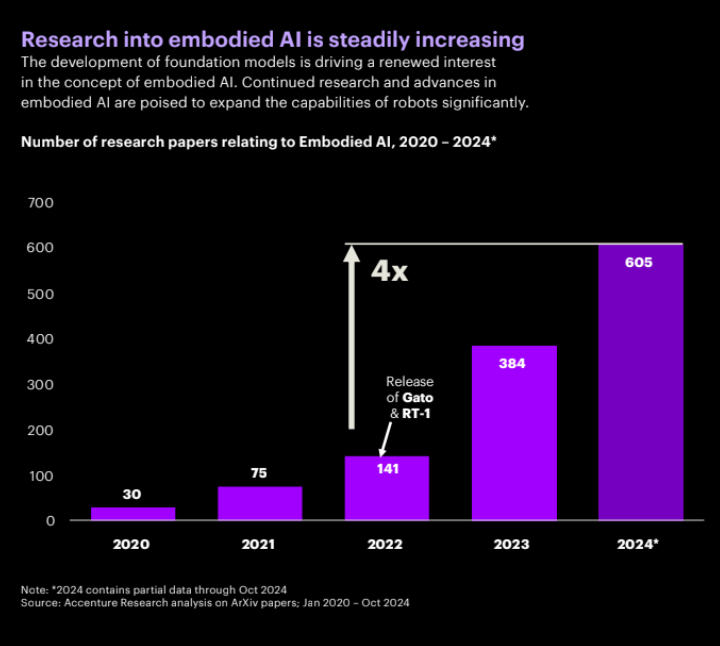Embodied AI

Key Takeaway:
This trend highlights how foundation models are revolutionizing robotics, enabling machines to operate with greater autonomy, contextual understanding, and reasoning. This marks a turning point for robotics, expanding their use beyond controlled environments like factories and warehouses into customer-facing roles, public spaces, and unpredictable settings. The convergence of AI, advanced sensors, declining hardware costs, and edge computing has removed historical barriers to robotic deployment. Combined with improving ROI metrics and labor shortages across industries, these advances are creating perfect conditions for widespread adoption.
Trend Type: Technology
Sub-trends: Embodied AI, Robotics & Automation, Autonomous robots for the elderly, AI-Driven Robotics, Spatial Computing
Embodied AI and Robotics
The integration of foundation models into robotics is revolutionizing how machines interact with the world, enabling them to reason, adapt, and operate autonomously in dynamic environments. AI-powered robots are no longer confined to factories and warehouses but are moving into customer service, healthcare, security, and public spaces, where they must navigate unpredictability. Advances in AI, edge computing, and declining hardware costs, combined with a tight labor market and improving return on investment (ROI), are driving widespread adoption.
Unlike their predecessors, which relied on predefined programming to execute repetitive tasks, today’s robots are evolving into generalist machines capable of real-time decision-making. The introduction of Large Language Models (LLMs) and Vision Language Models (VLMs) allows robots to process complex commands, understand their surroundings, and adapt to new situations. Humanoid robot, Figure 2, demonstrated these capabilities by autonomously recognizing objects and executing multi-step actions. Meanwhile, researchers from Stanford, Princeton, and Google DeepMind are enhancing robots’ ability to interact with physical environments through the PhysObjects dataset, which trains AI to comprehend properties such as weight, texture, and fragility.
These advancements are accelerating the development of multi-purpose, generalist robots capable of functioning in human-designed spaces. BMW is piloting OpenAI-powered humanoid robots in manufacturing, while Tesla and Hyundai are investing heavily in general-purpose robotics. The commercial viability of AI-powered humanoids is becoming increasingly tangible, with Tesla’s Optimus robot set for production in 2025 and commercial availability by 2026. Gartner predicts that by 2030, 80% of humans will engage daily with smart robots capable of performing multiple tasks — from delivering packages and assisting in healthcare to maintaining infrastructure — up from less than 10% today.

Source: Accenture Research
Autonomous Vehicles: The Expansion of Robotaxis
Autonomous vehicles are moving from experimental phases to real-world deployment, reshaping transportation, logistics, and urban mobility. With regulatory approvals expanding, companies are racing to scale their autonomous fleets, unlocking what IDTechEx forecasts as a $174 billion robotaxi market by 2045, with a 20-year CAGR of 37%.
As competition intensifies, industry leaders like Waymo, Tesla, Amazon’s Zoox, Baidu, and Pony.ai are aggressively expanding operations. Waymo’s driverless ride-hailing service, already operational in San Francisco, Los Angeles, and Phoenix, is set to expand into Austin and Atlanta by 2025. Meanwhile, Tesla plans to launch its robotaxi fleet in Austin by mid-2025, pending regulatory approval, while China is targeting 1 million robotaxis by 2030. Over 35 U.S. states now permit commercial robotaxi operations, though public skepticism and safety concerns remain key obstacles to mass adoption.
To ease these concerns, companies are positioning autonomous vehicles as public goods, offering free services such as senior mobility solutions and last-mile deliveries. The Bipartisan Policy Center (June 2024) reports that such initiatives are helping build trust, yet legal and cultural barriers persist.
At CES 2025, Nvidia CEO Jensen Huang declared that “autonomous vehicles have finally arrived,” citing Waymo’s October 2024 report that the Waymo One service completes over 150,000 paid trips per week. McKinsey forecasts autonomous driving could generate $300–$400 billion in revenue by 2035, as the industry pushes toward full autonomy. However, scaling these technologies requires continued advances in AI perception, regulatory harmonization, and secure real-time data processing—a challenge that companies like Kyndryl, which help enterprises modernize and manage complex telecom networks, are addressing through enhanced connectivity solutions.
Wearables: AI-Powered On-Demand Intelligence
AI-powered wearables are emerging as the next frontier of seamless, real-time digital assistance, designed to reduce reliance on traditional screens while enhancing productivity and interaction. The global wearable AI market, valued at $38.85 billion in 2024, is projected to reach $166.4 billion by 2030, growing at a CAGR of 29.8% (Grand View Research).
The industry’s focus is shifting from passive smartphone apps to interactive, voice-driven devices that integrate AI into daily life. Companies are developing AI-powered wearables—from smart necklaces to AR glasses—that provide instant access to information via conversational AI interfaces. Unlike smartphones, these wearables offer hands-free access to AI through natural voice commands, enhancing user experience while reducing screen dependence.
Smart glasses, in particular, are gaining traction as the next computing interface. The global smart glasses market, valued at $1.93 billion in 2024, is forecast to grow at a CAGR of 27.3% between 2025 and 2030 (Grand View Research). Companies like Phantom Technology are launching lightweight augmented reality devices, such as Journey Lens, which overlays digital information onto real-world environments. While high costs currently limit consumer adoption, enterprise applications in logistics, healthcare, and field operations are driving early adoption.
Major tech players are betting that AI-powered wearables will reshape how users interact with digital content, moving away from screen-based engagement toward immersive, context-aware computing.
Use Cases
Wearables: The Journey Lens is a new product from Phantom Technology Limited meant to take advantage of having in a pair of glasses, the full AR capabilities like Meta’s Orion combine the smart glasses pros of the Meta Ray-Bans.
Wearables: Motorola thinks we may be wearing our phones on our wrist in future. The company, which is owned by Chinese tech giant Lenovo, showed off a bendable smartphone during the Mobile World Congress in Barcelona, Spain.
Embodied AI: The BMW Group is exploring the use of humanoid robots in production for the first time. During a trial run lasting several weeks at BMW Group Plant Spartanburg, the latest humanoid robot Figure 02 from California company Figure successfully inserted sheet metal parts into specific fixtures, which were then assembled as part of the chassis.
Spatial Computing: Gemini Robotics brough Gemini 2.0’s model intelligence to the physical world by enabling robots to be interactive, responding live to actions and voice commands. It makes robots dexterous, allowing them to perform complex tasks like folding origami through advanced spatial understanding. The system is also general, reasoning across new, unseen tasks without prior training.
Use Cases
Sub-Trend Sources
Embodied AI: Accenture Tech Vision, Kyndryl, MIT 10 Breakthrough Technologies, Trend Hunter, VML The Future 100
Robotics & Automation: BBVA Spark Tech Trends, Gartner: Top10 Strategic Tech Trends, MIT 10 Breakthrough Technologies, VML The Future 100
AI-Driven Robotics: Capgemini Top Tech Trends, Future Today Institute
Autonomous robots for the elderly: CB Insights Tech Trends
Spatial Computing: CB Insights Tech Trends, Deloitte Tech Trends, eMarketer Tech Trends and Predictions, Gartner: Top10 Strategic Tech Trends, Trend Hunter, VML The Future 100
What to Read Next
Energy Challenge
The Collision of AI and Energy Demand The rise of generative AI is not only transforming digital landscapes—it’s also reshaping the global energy equation. According to Deloitte, the rapid expansion[...]
IT Amplified
The Rise of AI-Driven IT Transformation As the tech function evolves from leading digital transformation to leading AI transformation, IT is being amplified across every dimension. Deloitte’s foresight analysis suggests[...]
Cybersecurity
From Fatigue to High-Stakes Transformation Cybersecurity may no longer feel like a ‘shiny new thing,’ but its strategic urgency is only growing. While some executives claim fatigue—arguing it’s been over-discussed—the[...]
What to Read Next
Energy Challenge
The Collision of AI and Energy Demand The rise of generative AI is not only transforming digital landscapes—it’s also reshaping the global energy equation. According[...]
IT Amplified
The Rise of AI-Driven IT Transformation As the tech function evolves from leading digital transformation to leading AI transformation, IT is being amplified across every[...]
Cybersecurity
From Fatigue to High-Stakes Transformation Cybersecurity may no longer feel like a ‘shiny new thing,’ but its strategic urgency is only growing. While some executives[...]



